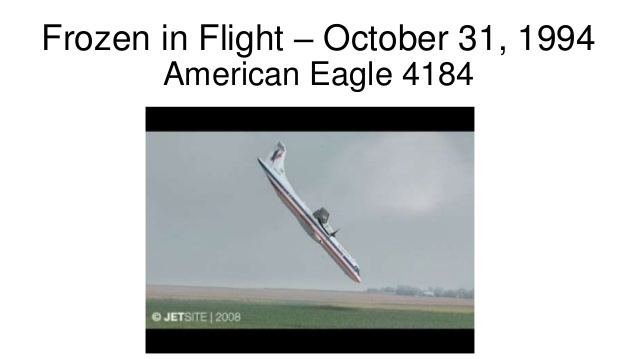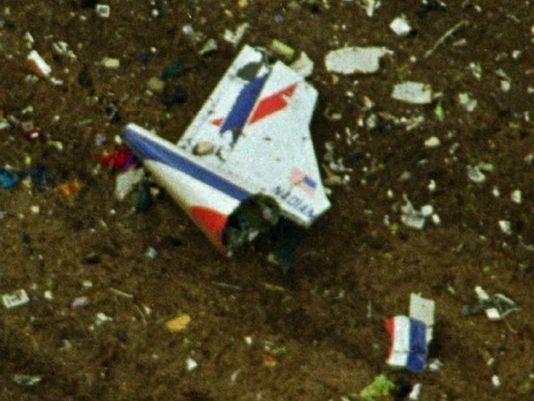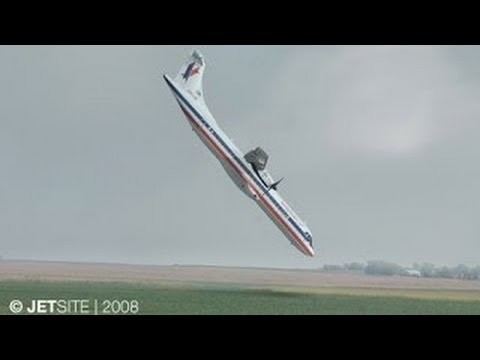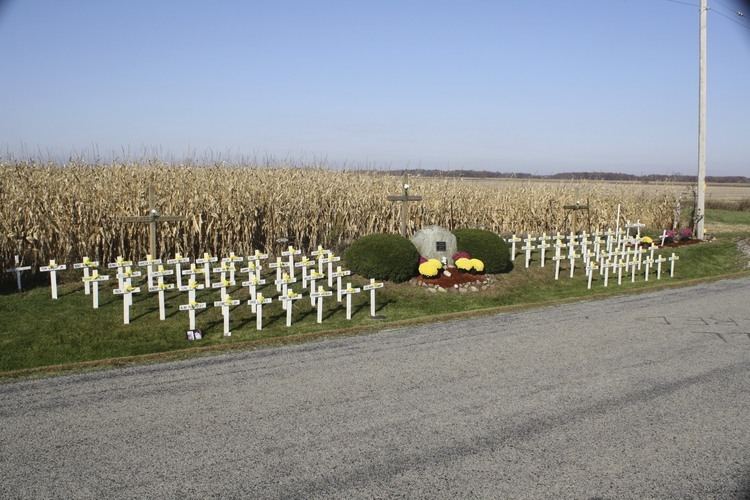Passengers 64 Total fatalities 68 (all) Passenger count 64 | Survivors 0 Date 31 October 1994 Survivor 0 Crew count 4 | |
 | ||
Summary Atmospheric icing leading to loss of control Similar American Airlines Flight 96, Chalk's Ocean Airways F, Tuninter Flight 1153, American Airlines Flight 1420, Air Midwest Flight 5481 | ||
American Eagle Flight 4184 was a scheduled domestic passenger flight from Indianapolis, Indiana to Chicago, Illinois, United States. On October 31, 1994, the ATR 72 performing this route flew into severe icing conditions, lost control and crashed into a soybean field. All 68 people aboard were killed in the high speed impact.
Contents
- Frozen Horror Plane Crashes Just Before Landing in Chicago American Eagle Flight 4184
- Aircraft
- Passengers and crew
- Weather
- Accident
- Probable cause
- Aftermath
- Memorials
- Dramatization
- References
Frozen Horror | Plane Crashes Just Before Landing in Chicago | American Eagle Flight 4184
Aircraft

The aircraft involved, registration N401AM, was built by the French-Italian aircraft manufacturer ATR and was powered by two Pratt & Whitney Canada PW127 turbo-prop engines. It made its first flight on March 7, 1994, and was delivered to American Eagle on March 24, 1994. It was operated by Simmons Airlines on behalf of American Eagle. American Eagle was the banner carrier regional airline branding program of AMR Corporation's regional system, prior to the formation of the fully certificated carrier named American Eagle Airlines.
Passengers and crew

The captain of Flight 4184 was Orlando Aguiar, 29. He was an experienced pilot with almost 8,000 hours of flight time, including 1,548 hours in the ATR. Colleagues described Aguiar's flying skills in positive terms and commented on the relaxed cockpit atmosphere that he promoted. The first officer was Jeffrey Gagliano, 30. He was also considered to be a competent pilot by colleagues and he had accumulated more than 5,000 flight hours, of which 3,657 hours in the ATR. The two flight attendants were 27-year-old Sandi Modaff, and 23-year-old Amanda Holberg (it was her first day as a flight attendant with American Eagle).
Weather

The weather condition of the area of Roselawn, Indiana, was recorded by National Weather Service. The summary revealed a low pressure center in the area of west central Indiana, and "...cloud ceilings of less than 1,000 feet and/or visibilities of less than 3 miles, in rain," occurring in northern Indiana at 1600 local time. A cold front was also extended from the low pressure center in a southwesterly direction. The surface temperatures of the accident site was reported of 7 degrees Celsius.

NWS's analysis indicated a low pressure area with the center located in west central Indiana at 1800. The temperatures in the area where flight 4184 was holding were reported near 3 degrees Celsius with moisture evident. Temperatures were near minus 4 degrees Celsius with moisture evident in northern Indiana.

The weather conditions provided by Lowell Airport, which located about 12 nautical miles northwest of the accident site, indicated broken clouds at 1400 ft, overcast at 3000 ft, gusty winds from southwest at 20 knots, with light drizzle falling. However, the report was estimated that the observation was made about 30 minutes after the accident.
Accident
The flight was en route from Indianapolis International Airport, Indiana, to O'Hare International Airport, Chicago, Illinois. Bad weather in Chicago caused delays, prompting air traffic control to hold Flight 4184 over the nearby LUCIT intersection at 10,000 ft (3,000 m). While holding, the plane encountered freezing rain, a dangerous icing condition where supercooled droplets rapidly cause intense ice buildup. Soon after, they were cleared to descend to 8,000 ft (2,400 m). After this descent the pilots were ordered to enter another hold. During the descent, a warning sound indicating an overspeed warning due to the extended flaps was heard in the cockpit. After the pilot took action by retracting the flaps, a strange noise was heard on the cockpit voice recorder, followed by an uncommanded roll excursion that disengaged the autopilot. Flight recorder data showed that the aircraft subsequently went through at least one full roll, after which Aguiar and Gagliano regained control of the rapidly descending aircraft. However, another roll occurred shortly thereafter. Fewer than thirty seconds later, at 3:59 p.m., contact was lost as the plane crashed into a soybean field near Roselawn, Indiana, killing all 64 passengers and 4 crew on board.
The disintegration of the plane indicated extreme velocity, and data recovered from the flight data recorder showed that the plane had an indicated airspeed of 375 knots (694 km/h) at impact. There was no explosion or post-impact fire, as the high speed of the impact caused the fuel to disperse before it could ignite. The bodies of all on board were fragmented by the impact forces, therefore the crash site was declared a biohazard.
Flight 4184 was the first loss and also the highest death toll of any aviation accident involving an ATR 72 aircraft. (Aero Caribbean Flight 883 crashed in 2010 had an equal death toll). Robert A. Clifford, a Chicago airplane accident attorney, represented 16 of the victims. As the trial was ready to begin, the defendants agreed to a record $110 million settlement and an apology from both the manufacturer and the airline in open court.
Probable cause
The National Transportation Safety Board (NTSB) issued its usual statement of "probable cause" near the end of its report. However, that statement was considerably longer than the norm for most other NTSB accident reports. The NTSB found that ATR (the manufacturer of that aircraft), the French Directorate General for Civil Aviation (the French counterpart of the American FAA), and the FAA itself, had each contributed to that accident, because they had each failed in their duty to ensure the highest possible level of safety to the traveling public.
The unabridged NTSB "probable cause" statement reads:
Aftermath
In the years following this accident, AMR Corporation stopped using its American Eagle ATRs out of its northern hubs and moved them to its southern and Caribbean hubs at Dallas-Fort Worth International Airport, Miami, Florida, and San Juan, Puerto Rico, to reduce potential icing problems in the future. Other U.S. former ATR operators, particularly the SkyWest, Inc., subsidiary and Delta Connection operator Atlantic Southeast Airlines, operated ATR 72 aircraft in areas where icing conditions were not common.
In April, 1996 the American FAA issued 18 Airworthiness Directives (ADs) affecting 29 turboprop aircraft which had the combination of unpowered flight controls, pneumatic deicing boots and NACA "five-digit sharp-stall" airfoils. They included significant revisions of pilot operating procedures in icing conditions (higher minimum speeds, non-use of the autopilot, different upset recovery procedures) as well as physical changes to the coverage area of the de-icing boots on the airfoils.
While the ATR 42 and ATR 72 aircraft are now compliant with all icing condition requirements imposed by those 18 ADs, the de-icing boots still only reach back to 12.5% of the chord. Prior to the accident, they had extended only to 5% and 7%, respectively. Robert Boser believes the ADs still fail to deal with the findings of tests conducted by British regulators at MoD Boscombe Down, which demonstrated that ice could form as far back on the wing as 23% of the chord, and on the tail at 30% of the chord. Both percentages are well beyond the reach of the extended deicing boots installed in compliance with the FAA ADs. Those tests limited the size of the droplets to 40 micrometres, near the maximum limit of the FAA design certification rules for Transport Category aircraft (Part 25, Appendix C), still in effect at that time of the Roselawn crash. "Extensive airborne testing" following the accident revealed that airliners can encounter water droplets exceeding 200 micrometers in average diameter. It is likely that the lack of further ATR icing accidents is attributable to the changes in pilot operating procedures, as well as the moving of those aircraft to operating areas where severe icing is not a problem, rather than to the modest extension of the de-icer boots to 12.5% of the chord.
Memorials
There are three designated memorials for Flight 4184. The first is a roadside memorial at the crash location just outside Roselawn, Indiana. The second is located at Calumet Park Cemetery, in Merrillville, Indiana, where 18 caskets of unidentified remains were interred. The third is located at the Lincoln Township Fire Department in Thayer, Indiana, the station from which the first emergency responders came to the crash site.
Dramatization
This crash was featured on an episode of the Discovery Channel program The New Detectives. In the episode, entitled "Witness To Terror," the narrator gives an incorrect figure of 72 victims being killed on the flight. The crash was also featured in the theatrical production Charlie Victor Romeo.
The crash was featured in Season 7 of the Canadian made, internationally distributed documentary series Mayday, on the episode "Frozen in Flight".
The crash was also briefly mentioned in an episode of Modern Marvels (Sub Zero) on The History Channel.
